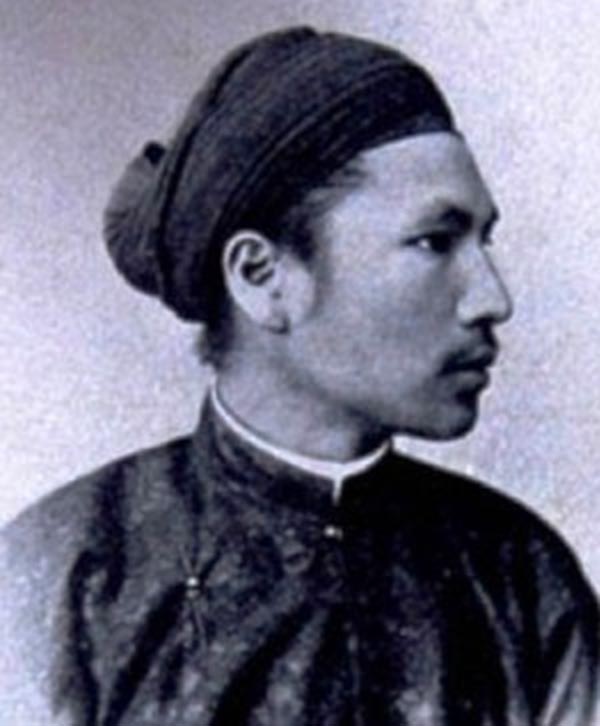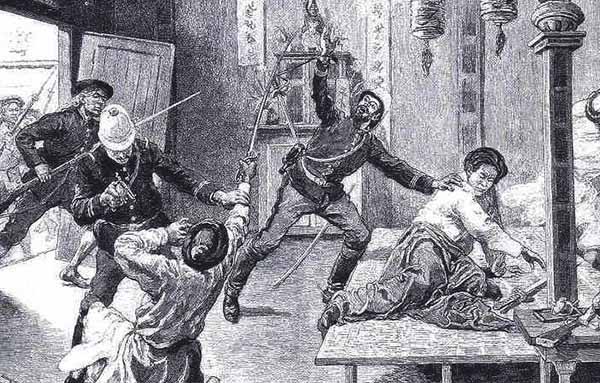The years of exile of the patriotic king Ham Nghi – the story is told now
Later, he was exiled by the French government in Alger – the capital of Algeria and died here in 1943. Compared to King Duy Tan, another patriotic king who was also exiled and died abroad, the There is very little information about the patriotic king Ham Nghi today.
The pitiful thing is that while King Duy Tan’s remains have been brought home and buried in Hue for a long time, King Ham Nghi’s remains are still lying cold in a foreign land. During this business trip to Europe, I went to Thonac village in Dordogne province – West Central of France to visit his grave and collect more documents about the years of exile in foreign countries to understand. More about the life of a patriotic king has many mysteries.

Journalist Hoang Anh Sung at the grave of patriotic king Ham Nghi in France
The patriotic king Ham Nghi, whose name is Nguyen Phuc Ung Lich, was born on June 17, Tan Mui year, ie August 3, 1871 (it is documented that he was born on July 22, 1872) in Hue. He is the fifth child of King Kien Thai Nguyen Phuc Hong Cai and Mrs. Phan Thi Nhan. He is also the younger brother of King Kien Phuc ( Ung Dang ) and King Dong Khanh ( Chanh Mong or Ung Ky ).
During the reign of King Dong Khanh, the people of Hue made a folk song: “One family gives birth to three kings. The king survives, the king dies, the loser runs away”. The three kings that Hue people refer to in this folk song are three siblings. “King still” is King Dong Khanh. The “lost king” is King Kien Phuc and the “long loser king” is King Ham Nghi.
Actually, Kien Thai King Nguyen Phuc Hong Cai, the father of King Ham Nghi, was never king. He is the younger brother of King Tu Duc. During his life, King Tu Duc had no son, so he adopted all three of his younger brother’s children as his own. History is ironic when all three of these people later ascended the throne and all had a sad fate like the above quote.

King Ham Nghi (1871-1943) was the 8th Emperor of the Nguyen Dynasty, the last feudal dynasty in Vietnamese history.
It should also be added that, after King Tu Duc died in July 1883, King Duc Duc succeeded to the throne only 3 days and was deposed by his assistants Nguyen Van Tuong and Ton That Thuyet. In turn, he ascended to the throne as King Hiep Hoa and then Kien Phuc.
Especially, after the sudden death of King Kien Phuc in the context of the war faction in the court led by Ton That Thuyet, according to the theory at that time, Nguyen Phuc Ung Ky (later King Dong Khanh) was his brother. and also the adopted son of King Tu Duc will be put on the throne. However, the warring factions found that if an elderly person like Nguyen Phuc Ung Ky, then 20 years old, ascended the throne, he would easily lose his power. And so, the 13-year-old boy Ung Lich was chosen to take the throne in the troubled context of the times.
Unlike his two biological brothers, Ung Lich is the son of a concubine, so since childhood he did not live in a palace but lived in a rural countryside in poverty with his birth mother. When the messenger came to pick him up, the boy Ung Lich was playing with his friends outside the gate of Dong Ba. When your mother heard that you were crowned king, she was too scared because she was worried that her son would also die of unknown causes like the previous kings. She threw herself into the bodyguards and wept bitterly, refusing to let them take her son away. As for the boy Lich, he was too scared to accept the hats offered by people.
On the morning of June 12, Giap Than year, ie August 2, 1884, Ung Lich was led between two lines of bodyguards, entered Thai Hoa Palace to celebrate the enthronement ceremony, and set the era name as Ham Nghi. The first job that King Ham Nghi had to play, under the guidance of Ton That Thuyet, was to organize the reception of the French delegation from the Nuncio on the south bank of the Perfume River to Thai Hoa Palace to celebrate the king’s enthronement.
At 9:00 a.m. on August 17, 1884, a French delegation consisting of Colonel Marcel Guerrier, Ambassador Rheinart, Captain Wallarrmé and 185 officers and soldiers pulled to the Imperial Citadel of Hue. Guerrier forced the Hue court to let the entire French army enter Ngo Mon by the middle way, which is only for the king to go, but Ton That Thuyet definitely refused. In the end, only 3 messengers can enter the main gate, the rest of the members go through the gate on both sides.
Both the Hue court and the French delegation expressed their displeasure, but the ordination ceremony finally ended peacefully. When the French delegation left, Ton That theory secretly let the troops close the main gate at Ngo Mon, so the French delegation had to follow two side doors to return.

Two assistant chief ministers Ton That Thuyet and Nguyen Van Tuong
Commenting on this action, Marcel Gaultier wrote: “King Ham Nghi has kept the sacredness of his subjects. Unwittingly, the young king did something that had a resounding effect throughout the country: with his will. independence and even though the French were stationed in Hue, the Annam court still displayed an attitude that was not cowardly, which was set forth by the Main Sub-Council. depend on the king’s attitude to follow, see it as an order against the unspoken French”.
In 1885, General De Courcy was sent by the French Government to Vietnam to assist in the establishment of a protectorate. General De Courcy wanted to visit King Ham Nghi, but he wanted all his troops, including 500 people, to enter the main door, which is reserved for great guests. The Hue court asked to let the soldiers go through the door on both sides, only the generals would go to the main door in accordance with the royal etiquette, but De Courcy definitely refused. This overbearing, insolent attitude of De Courcy angered the whole court.
On the night of July 5 and early morning, July 6, 1885, or May 23, the year of the Rooster, Ton That Thuyet ordered his troops to attack the French at Mang Ca fortress and Hue Embassy. With advanced weapons, the French counterattacked. Our army lost. Historian Tran Trong Kim recorded in the book “A brief history of Vietnam”: “The battle in Hue, the French lost 16 men, 80 were wounded. Western books record that our army died up to several thousand people, how much air was left. World, food and more than a million money were all lost.
Faced with this urgent situation, Ton That Thuyet took King Ham Nghi and the three palaces far from the price to Quang Tri. Arriving in Quang Tri, Ton That Thuyet divided into two groups: the three palaces and the elderly returned to Hue, King Ham Nghi and his generals went to Tan So base in Cam Lo, Quang Tri to organize a long resistance war. Here, on June 2 of the year of the Rooster, ie July 13, 1885, King Ham Nghi issued “Chieu Can Vuong”, calling on nobles, scholars and people across the country from the North to the South to stand up and destroy the invaders. colonists invaded to regain independence and freedom for the country.
The call of the young patriotic king moved people’s hearts and awakened the hearts of the elite and the people throughout the country. Since then, a patriotic movement against aggression has surged like a storm, lasting until the end of the 19th century, called Can Vuong movement. Regarding the evolution of the movement, it can be divided into two phases: 1885 – 1888 and 1888 – 1896. In the period 1885 – 1888, the movement exploded throughout the country, most excitingly in the provinces of Trung Ky and Tonkin.

Painting of patriotic king Ham Nghi being captured by the French in Quang Binh
Seeing that Tan So area was narrow and easily surrounded by enemies, Ton That Thuyet continued to take King Ham Nghi across Truong Son to the North and set up a base in Phu Gia village, Huong Khe district (Ha Tinh). The base covers the western three provinces of Nghe An, Ha Tinh, and Quang Binh and spreads to Laos. On the way, the king received the dedicated and thoughtful help of ethnic people in the border area between Vietnam and Laos.
While King Ham Nghi was out of town, on September 19, 1985, the French colonialists brought the king’s brother (with the same father, different mother) to the throne, with the reign of Dong Khanh. Terrified by the French resistance movement of the whole country, the French colonialists took King Dong Khanh far away from Quang Binh to lure King Ham Nghi and his courtiers such as: Phan Dinh Phung, Tran Xuan Soan, Nguyen Pham Tuan, Le Truc, Ton That Thiep (Tiep), Ton That Dam (Dam) surrendered but to no avail. The three empress dowagers also repeatedly sent letters to the king calling for his return, but he firmly refused. The king often said that he would rather die in the forest than return to be king and stay in the outlaws of a foreign country.
The resistance war at the headquarters lasted for 3 years in the extremely difficult context, causing King Ham Nghi’s forces to gradually retreat into the mountains. In September 1888, one of the king’s attendants, Nguyen Dinh Tinh, surrendered to the French and clarified the situation and where the king was stationed. The French army immediately sent Nguyen Dinh Tinh to lure the king’s bodyguard, Truong Quang Ngoc, so that both of them could find a way to capture the king.
The resistance war is getting more and more difficult. Ton That Thuyet was forced to go to the Qing Dynasty to ask for help, assigning the responsibility of protecting King Ham Nghi to his children, Ton That Thiep and Ton That Dam. Obeying his father, Ton That Thiep vowed to live and die with the king and behead anyone who intended to surrender to the French.
On the night of September 26, 1888, two rebels Truong Quang Ngoc and Nguyen Dinh Tinh and dozens of soldiers secretly pulled to Tra Bao village, where King Ham Nghi was stationed. In the middle of the night, they suddenly burst into the house. Ton That Thiep was sleeping so he was stabbed to death. King Ham Nghi held a sword and pointed at the traitor Truong Quang Ngoc, shouting: “You better kill me than bring me back to the West”. Another rebel quickly snatched his sword. The king was taken to a hammock and then a boat back to Quang Binh.
Another son of Ton That Thuyet, Ton That Dam, was responsible for protecting the base, protecting the king, hearing that the king was captured by the enemy, he committed suicide.
After being arrested, King Ham Nghi said to the traitors and the French colonialists: “Well, I have to follow the orders of heaven. They can do whatever they want. They can eat my flesh.”.
The French colonialists still treated the king according to royal etiquette and at one time considered making him king of 4 provinces of Thanh Hoa, Nghe An, Quang Binh, and Quang Tri, but he always denied that he was not Ham Nghi. The French colonialists were skeptical at times, but once the king’s teacher, Nguyen Than, came to visit, the king stood up to greet him, so the French knew exactly that this was King Ham Nghi.
The French brought Ham Nghi back to Hue, allowing the king to meet his blood relatives, but he refused: “I am already in prison, the country is lost, dare to think about my parents, brothers and sisters?”.
On the afternoon of November 25, 1888, the French took the king off the ship La Comète to Saigon. December 12, 1888, put on board Bien Hoa ship to Africa. On January 13, 1899, the ship arrived in Alger, the capital of Algeria, and the king began his life in exile.
There’s more….
Youth life
at Blogtuan.info – Source: cafebiz.vn – Read the original article here



